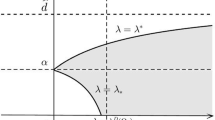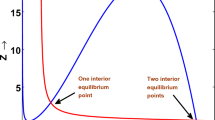Abstract
The evolution and local stability of a system of two interacting species in a finite two-dimensional habitat is investigated by taking into account the effects of self- and cross-dispersion and convection of the species. In absence of cross-dispersion, an equilibrium state which is stable without dispersion is always stable with dispersion provided that the dispersion coefficients of the two species are equal. However, when the dispersion coefficients of the two species are different, the possibility of self-dispersive instability arises. It is also pointed out that the cross-dispersion of species may lead to stability or instability depending upon the nature and the magnitude of the cross-dispersive interactions in comparison to the self-dispersive interactions.
The self-convective movement of species increases the stability of the equilibrium state and can stabilize an otherwise unstable equilibrium state. The effect of cross-convection (in absence of self-dispersion and self-convection) is to stabilize the equilibrium state in a prey-predator model with positive cross-dispersion coefficients for the prey species. Finally, it is shown that if the system is stable under homogeneous boundary conditions it remains so under non-homogeneous boundary conditions.
Similar content being viewed by others
Literature
Comins, H. N. and D. W. E. Blatt. 1974. “Prey-Predator Models in a Spatially Heterogeneous Environment.”J. Theor. Biol. 48, 75–83.
Dubois, D. M. 1975. “A Model of Patchiness for Prey-Predator Plankton Populations.”Ecol. Modelling 1, 67–80.
Gomatam, J. 1974. “A New Model for Interacting Populations 1.”Bull. Math. Biol. 36, 347–353.
Gopalsamy, K. 1977. “Competition, Dispersion and Coexistence.”Math. Biosci. 33, 25–33.
Gurney, W. S. C. and R. M. Nisbet. 1975. “A Note on Nonlinear Population Transport.”J. Theor. Biol. 56, 249–251.
Hadeler, K. P., V. Heiden and F. Rothe. 1974. “Nonhomogeneous Spatial Distributions of Populations.”J. Math. Biol. 1, 165–176.
Huffaker, C. B. 1958. “Experimental Studies on Predation; Dispersion Factors and Prey-Predator Oscillations.”Hilgardia 27, 305–329.
—. 1963. “Experimental Studies on Predation: Complex Dispersion and Levels of Food in an Acarine Predator-Prey Interactions.”Hilgardia 37, 305–309.
Jorne, J. 1974. “The Effects of Ionic Migration on Oscillations and Pattern Formation in Chemical Systems.”J. Theor. Biol. 43, 375–380.
—. 1975. “Negative Ionic Cross Diffusion Coefficients in Electrolytic Solutions.”J. Theor. Biol. 55, 529.
Kerner, E. H. 1959. “Further Considerations on Statistical Mechanics of Biological Associations.”Bull. Math. Biophys. 21, 217–255.
Landahl, H. D. 1959. “A Note on the Population Growth under Random Dispersal.”Bull. Math. Biophys. 21, 153–159.
Levin, S. A. 1974. “Dispersion and Population Interactions.”Am. Nat. 108, 207–228.
Levins, R. and D. Culver. 1971. “Regional Coexistence of Species and Competition Between Rare Species.”Proc. Nat. Acad. Sci. 68, 1246–1248.
McMurtrie, R. E. 1978. “Persistence and Stability of Single Species and Prey-Predator Systems in Spatially Heterogeneous Environment.”Mathl. Biosci. 39, 11–51.
Maynard Smith, J. 1974.Models in Ecology. Cambridge: Cambridge University Press.
Rosen, G. 1977a. “Effects of Diffusion on the Stability of the Equilibrium in Multispecies Ecological Systems.”Bull. Math. Biol. 39, 373–383.
— 1977b. “On the Persistence of Ecological Systems.”J. Theor. Biol. 65, 795–799.
Segal, L. A. and J. L. Jackson. 1972. “Dispersive Structure: An Explanation and an Ecological Example.”J. Theor. Biol. 37, 545–559.
Skellam, J. G. 1951. “Random Dispersal in Theoretical Population.”Biometrika 38, 196–218.
Smith, E. F. 1972. “Spatial Heterogeneity, Stability, and Density in Ecosystems.” InGrowth by Intussusception: Ecological Essays in Honor of G. Evelynn Hutchinson; Trans. Conn. Acad. Astrol. Sci. 44, 309–335.
Author information
Authors and Affiliations
Rights and permissions
About this article
Cite this article
Shukla, J.B., Verma, S. Effects of convective and dispersive interactions on the stability of two species. Bltn Mathcal Biology 43, 593–610 (1981). https://doi.org/10.1007/BF02462315
Received:
Revised:
Issue Date:
DOI: https://doi.org/10.1007/BF02462315




